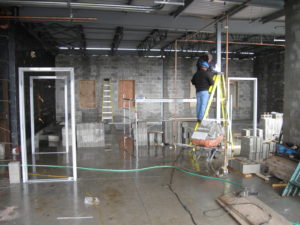
Okay. I’m going to go there. With forty years of architectural experience I simply can’t waste this while it’s fresh in my mind. This will be the first in a series of four posts that will examine how building projects are designed and constructed (at least in NL). These are not intended to be educational. They are intended to explore a number of things, such as:
- What delivery methods are most likely produce quality buildings and quality architecture;
- What delivery methods represent the best bang for the client, especially if the client is ultimately the taxpayer; and
- Which delivery methods have been so bastardized by the bureaucratic or (so-called) project management process that they are barely recognizable as any sort of logical, practicable or cost-effective process?
The traditional design and construction process involves three facets of project delivery: design, bid and build. An architect enters into an agreement with a client to design a building based on a functional program of spaces and adjacencies. He or she goes through a prescribed series of steps to develop a building concept and prepare construction documents that general contractors can bid on. Once the winning bid has been established (typically the lowest qualified) the general contractor mobilizes forces and construction begins. The architect’s team (including multi-discipline engineers) oversees the construction on behalf of the client through to final inspection, and ultimately, handover.
That’s as short as I can make it for background purposes. And up until about twenty years ago, this was the norm.
The most telling part of this process is that the architect is responsible throughout to protect the client’s best interests and see that he/she gets a quality product. However, the definition of a quality product is often debatable, especially for public sector projects where cost and schedule are the quality yardsticks used by civil servants.
In the private sector, architects most often get into trouble when they don’t make the effort to educate their clients about the vagaries of the construction industry. The fact that we are mere mortals doesn’t seem to be any sort of excuse. The design and construction process is not perfect especially when it comes to predictions of cost. If you believe it should be, then you have never renovated your kitchen.
But the greatest pitfall is tendering, which is, in all but the rarest cases, awarded to the lowest bidder. Despite many high calibre, skilled contractors out there, consider for a moment all the plausible reasons why Contractor X is the low bidder. Come on – this is not such a stretch! An error? Carrying the prices of the worst subtrades in the business? Bidding without profit margin just to maintain a work force? Hoping that the fact that no money has been carried to actually manage the project in a timely and cost effective manner will go largely unnoticed?
The architect therefore is typically staring down a long, hard road – about to be carried along by a contractor whose sole aim is to get back all the money absent in his bid. What was “left on the table” in industry lingo.
So Public Tendering Act should immediately come to mind. (Dolled up after an endless pretend engagement process and recently re-released as the Public Procurement Act.) This is the process whereby consultants, and in particular architects are set up for chronic failure. It doesn’t matter how good the construction documents are or how skilled your inspection protocol might be.
The contractors who are most notable for extras in contracts (i.e. additional cost claims) wield two tools: righteous indignation and the threat of litigation. The bigger the contracting company, the bigger the legal force behind it.
That is not to say there aren’t reputable contractors out there. There are many, but they are losing ground to those that my father would have labeled thus: “a bunch of ham-and-eggers”.
The private sector has more flexibility. It can tender by invitation. Typically the architect will suggest up to five reputable contractors to a client. By tacit implication, these are deemed to be pre-qualified and the lowest bid would not necessarily harbour risk of reputation. Things generally work out and everyone is happy. A quality building is the product. And perhaps if the stars align, a piece of architecture is added to the built environment.
Here, I will return to that well-intended but abysmal piece of crap legislation, the Public Tendering Act. Unless you were buying something as simple as pencils, it was a recipe for cooking up low quality, disappointing, unsustainable, expensive, and in the end, tasteless albatross. It was a political scapegoat. It turned bureaucrats into ostriches. It abandoned due process in favor of sheer laziness and incompetence. The new Procurement Act is supposed to focus on “best value” instead of “preferred bidder” suggesting that the low bid may no longer reign supreme.
A separate topic perhaps, as this legislation is relatively new, but it certainly has the potential to brew up a political patronage stew at its tastiest. The Telegram of November 22nd 2016 wrote: “To avoid potential corruption, the government is transforming the Government Purchasing Agency to a more arm’s-length agency, renamed the Public Procurement Agency.” Was this a suggestion that the agency could potentially be corrupted or that the process was corrupt in the first place?
But I digress …
The new act didn’t create the current project delivery mess in the various government departments that procure buildings, and it’s even less likely to fix it. Our provincial government long ago wandered away from Design, Bid, Build delivery to procure new buildings. Bureaucrats got tired of “going upstairs to the Minister’s office” to inform them of contract extras. A bureaucracy with even a modicum of intellect would have figured out that the Public Tendering Act was the problem. Instead, civil servants blamed local architects and engineering consultants for everything from cost overruns to poor construction. “We need a new approach!” they said. One that would bury true costs, eliminate innovation, ignore sustainability, and generally guarantee that the remotest suggestion of architectural design would be scrubbed under foot.
Enter Design-Build.
They would never again have to climb those dreaded stairs with bad news. The Minister would be happy.
(To be continued.)
